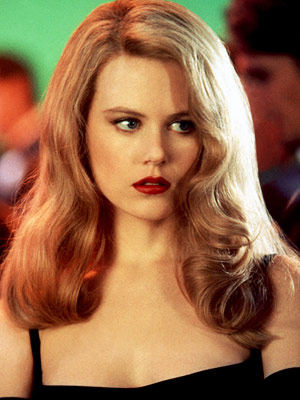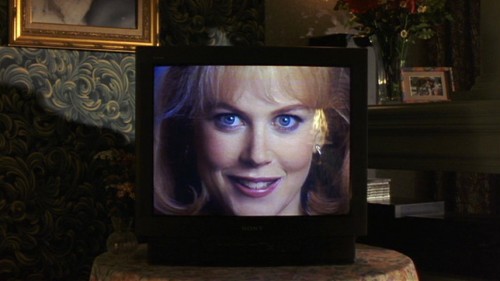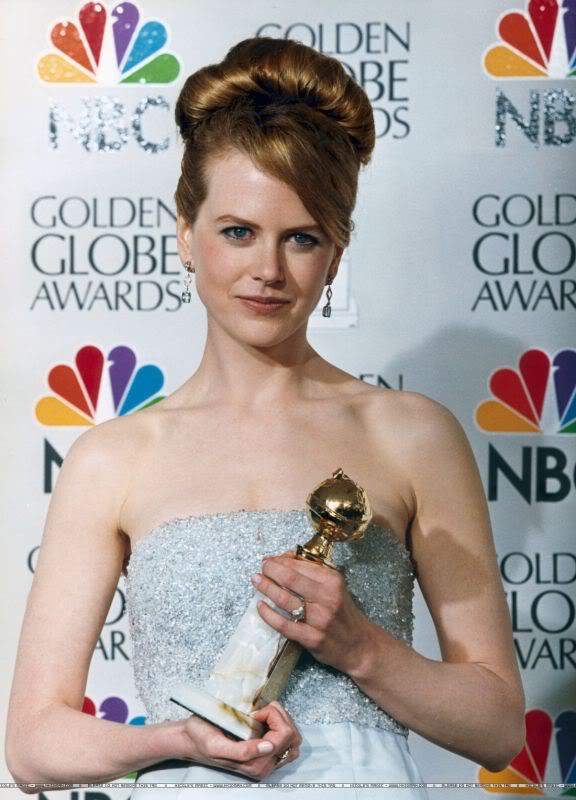TFE will be taking several trips back to 1995 for the next two weeks, our "year of the month". Here's abstew on the one and only... - Editor

Although she had been acting in Australia since she was 16 years old, most American audiences at the start of 1995 only knew Nicole Kidman for one thing: being Mrs. Tom Cruise. Despite earning strong notices earlier for 1989's Dead Calm (and catching the attention of superstar Cruise), the Hollywood productions that followed did little to showcase the promising talent that had been hinted at. Appearing alongside Cruise in glossy modest hits (Days of Thunder and Far and Away) or playing thankless wife roles that hardly challenged her as an actress (Malice, My Life), Kidman was in danger of becoming arm candy for her famous husband. But thanks to a new pair of roles, 1995 would become the year that she finally emerged from the shadow of Cruise to start the march to her own inevitable super-stardom.
 One of the ways Hollywood measures the worth of a star is by their box office. Warner Bros had been disappointed with the profits of Tim Burton's Batman Returns and decided to go in a different direction for the next franchise installment. Because of the changes, former star Michael Keaton decided not to return as the cape crusader and when Val Kilmer came onboard, it was deemed that Rene Russo (who had already been cast as the romantic lead) was too old to appear opposite the new Bruce Wayne. More...
One of the ways Hollywood measures the worth of a star is by their box office. Warner Bros had been disappointed with the profits of Tim Burton's Batman Returns and decided to go in a different direction for the next franchise installment. Because of the changes, former star Michael Keaton decided not to return as the cape crusader and when Val Kilmer came onboard, it was deemed that Rene Russo (who had already been cast as the romantic lead) was too old to appear opposite the new Bruce Wayne. More...
The part of psychologist Dr. Chase Meridian was then initially offered to Robin Wright, but leery of big-budget blockbusters, she turned it down. (Just as she had previously with the offer to play the role that went to Laura Dern in Jurrasic Park.) The part went to Kidman. At the time it had the biggest opening weekend gross of all time and would remain Kidman's most profitable film for over a decade.
Although having a film like Batman attached to her name certainly helped elevate her status in Hollywood, no one was attributing the success to Kidman. It was another girlfriend role requiring her to look very beautiful. Which she more than delivered, debuting a new straightened hair look that announced her intentions of stardom. Gone were the wild, frizzy curls of the Aussie tomboy, here was the cascading hair of '40s goddesses Rita Hayworth and Lauren Bacall; Kidman was letting everyone know that she intended to take her place among the great screen sirens. But Kidman needed more than just a damsel in distress role if she was ever going to be taken seriously in Hollywood. And the role that would bring her critical success, elevating her to the next level, just happened to be released that same year.

It's not that Kidman hadn't been trying to find more challenging roles once she made the move to Hollywood. She had worked to obtain leads in Thelma and Louise, Silence of the Lambs, Mary Reilly, and Ghost but lost out to American actresses that were more established than she was. And her role as Suzanne Stone in Gus Van Sant's To Die For, almost didn't happen for Kidman either. It was originally offered to Meg Ryan who eventually passed, allowing Kidman to step in to a project worthy of her talents and revealing just what she was capable of.
The film, adapted from Joyce Maynard's novel, was loosely based on real-life events involving Pamela Smart, a media coordinator in New Hampshire, that conspired with her teenage lover to kill her husband. But the screenplay from Buck Henry (the Oscar-nominated writer of The Graduate) became a pitch-black satire on fame, celebrity, and ambition. Pre-dating television's obsession with reality TV, where everyone can cash in on their 15 minutes of fame, the film skewers our culture's obsession with fame.

You're not anyone in America unless you're on TV."
And not that Kidman is necessarily like the narcissistic Suzanne, but there is certainly some pleasure in deriving parallels from her own life. Illeana Douglas' character at one point in the film describes Suzanne as a four letter word that starts with "C": cold. That description has often been used to describe Kidman's own perceived icy demeanor. (She attributes it to her shyness.) Suzanne thaws that cool exterior when using her sexuality to get what she wants, and Kidman proved that she was capable of melting her own chilly public persona with humor and a newfound scorching sensuality. (Particularly with a memorable dance in the rain, caught in the headlights of a car.) And just like her character, the actress certainly had her own ambitions to excel in her field (associations with her husband aside) though I doubt Kidman thought of going the same route to enter the spotlight!
 Speaking directly to the camera, Kidman had never been more at ease on film. It was as if the film's biting humor freed her to become more playful. Flirting with the audience, she seduces us to come around to her side. You can see how Joaquin Phoenix's Jimmy would kill for her. Kidman received year-end awards attention and even won the Golden Globe for Best Actress in a Musical or Comedy for playing Suzanne. For a moment it looked like she would score her first Oscar nomination but rumors that older Academy members walked out in the middle of screenings probably didn't help her. In the end she missed out on the nomination in a very competitive year, by how much we'll never know. Oscar could wait but 1995 was the year that changed Nicole Kidman's career. She entered the realm of A-list movie stars with a bona fide commercial hit and a revelatory artistic achievement all at once. And it's safe to say that no one has ever thought of her as "Tom Cruise's wife" ever since.
Speaking directly to the camera, Kidman had never been more at ease on film. It was as if the film's biting humor freed her to become more playful. Flirting with the audience, she seduces us to come around to her side. You can see how Joaquin Phoenix's Jimmy would kill for her. Kidman received year-end awards attention and even won the Golden Globe for Best Actress in a Musical or Comedy for playing Suzanne. For a moment it looked like she would score her first Oscar nomination but rumors that older Academy members walked out in the middle of screenings probably didn't help her. In the end she missed out on the nomination in a very competitive year, by how much we'll never know. Oscar could wait but 1995 was the year that changed Nicole Kidman's career. She entered the realm of A-list movie stars with a bona fide commercial hit and a revelatory artistic achievement all at once. And it's safe to say that no one has ever thought of her as "Tom Cruise's wife" ever since.